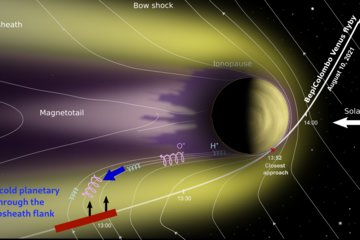All genres
201.
Talk
The Astrobiological Relevance of Comets. Japanisch-Deutsches Kolloquium, Kiel, Germany (2015)
202.
Talk
Dust Impact Monitor (SESAME-DIM) on board Philae - Measurements at comet 67P/C-G. European Geosciences Union General Assembly, Vienna, Austria (2015)
203.
Talk
Philae Dust Measurements at Comet 67P/Churyumov-Gerasimenko. Cosmic Dust Conference, Tokyo, Japan (2015)
204.
Talk
Rosetta - Rendezvous mit einem Kometen. Vortragsreihe "Raumfahrt aus Leidenschaft'' an der Universität Stuttgart, Institut für Raumfahrtsysteme, Stuttgart (2014)
205.
Talk
Rosetta - Rendezvous mit einem Kometen. Sternwarte Radebeul : Tag der Astronomie, Radebeul (2014)
206.
Talk
Grain Properties at the Nucleus of Comet 67P/C-G. 37th Rosetta Science Working Team Meeting, Villafranca del Castillo, Spain (2014)
207.
Talk
Rosetta - Rendezvous mit einem Kometen. Astronomie-Stiftung Trebur, Trebur, Germany (2014)
208.
Talk
Rosetta: Rendezvous mit einem Kometen. Lehrerfortbildung, Sonneberg, Germany (2014)
209.
Talk
Raumsonde Rosetta - Verabredung mit einem Kometen. Volkshochschule, Hildesheim, Germany (2014)
210.
Talk
Rosetta/Philae kurz vor der Landung auf dem Kometen Tschurjumov-Gerasimenko. Volkshochschule Mosbach (Baden), Binau, Germany (2014)
211.
Talk
Dust Impact Monitor DIM Onboard Rosetta/Philae: Calibration Experiments with Ice Particles as Cometary Analogue Materials. Asteroids, Comets Meteors Conference, Helsinki, Finland (2014)
212.
Poster
Cometary dust trail simulations for the Martian Moons Exploration (MMX) mission. EPSC-DPS Joint Meeting , Geneve, Switzerland (2019)
213.
Poster
Interstellar Dust in the Solar System: Model versus In-Situ Spacecraft Data. European Geophysical Union General Assembly, Vienna, Austria (2019)
214.
Poster
The Philae Science at 67P/Churyumov-Gerasimenko in Pictures, Tables, Figures and Numbers. Asteroids, Comets, Meteors 2017, Montevideo, Uruquay (2017)
215.
Poster
Assessing the Primordial Character of Comets and of 67P/Churyumov-Gerasimenko. 50th ESLAB Symposium 2016, Leiden, Netherlands (2016)
216.
Poster
Assessing the Primordial Character of Comets and of 67P/Churyumov-Gerasimenko. COMETS 2016, Toulouse, France (2016)











